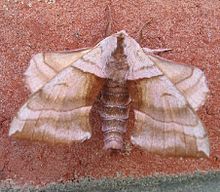Amorpha juglandis
| Walnut Sphinx | |
|---|---|

| |

| |
| Scientific classification | |
| Kingdom: | |
| Phylum: | |
| Class: | |
| Order: | |
| Family: | |
| Genus: | |
| Species: | A. juglandis
|
| Binomial name | |
| Amorpha juglandis (J. E. Smith, 1797)[1]
| |
| Synonyms | |
| |
The Walnut Sphinx (Amorpha juglandis) is a moth of the family Sphingidae. It is native to North America, where it is distributed from the Atlantic Ocean to the Rocky Mountains in Canada and the United States.
The wingspan is 45–75 mm. The adult moth is nocturnal, active mainly during the early hours of the night.
The caterpillar feeds on alder (Alnus), hickory (Carya), hazelnut (Corylus), beech (Fagus), walnut (Juglans), and hop-hornbeam (Ostrya) species. When attacked by a bird, the caterpillar produces a high-pitched whistle by expelling air from pair of spiracles in its abdomen. This antipredator adaptation may startle the bird, which may then reject the caterpillar.[2]
References
- ^ "CATE Creating a Taxonomic eScience - Sphingidae". Cate-sphingidae.org. Retrieved 2011-11-01.
- ^ Fullard, James H.; Napoleone, Nadia (2001). "Diel flight periodicity and the evolution of auditory defences in the Macrolepidoptera". Animal Behaviour. 62 (2): 349. doi:10.1006/anbe.2001.1753.
Further reading
- Bura, V. L.; Rohwer, V. G.; Martin, P. R.; Yack, J. E. (2010). "Whistling in caterpillars (Amorpha juglandis, Bombycoidea): Sound-producing mechanism and function". Journal of Experimental Biology. 214 (Pt 1): 30–7. doi:10.1242/jeb.046805. PMID 21147966.
- Knight, K. (2010). "Whistling Caterpillars Startle Birds". Journal of Experimental Biology. 214 (Pt 14): ii. doi:10.1242/jeb.054155. PMID 21834205.
External links

